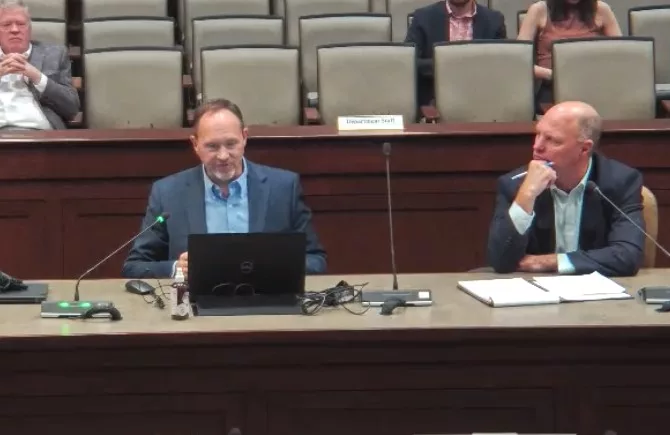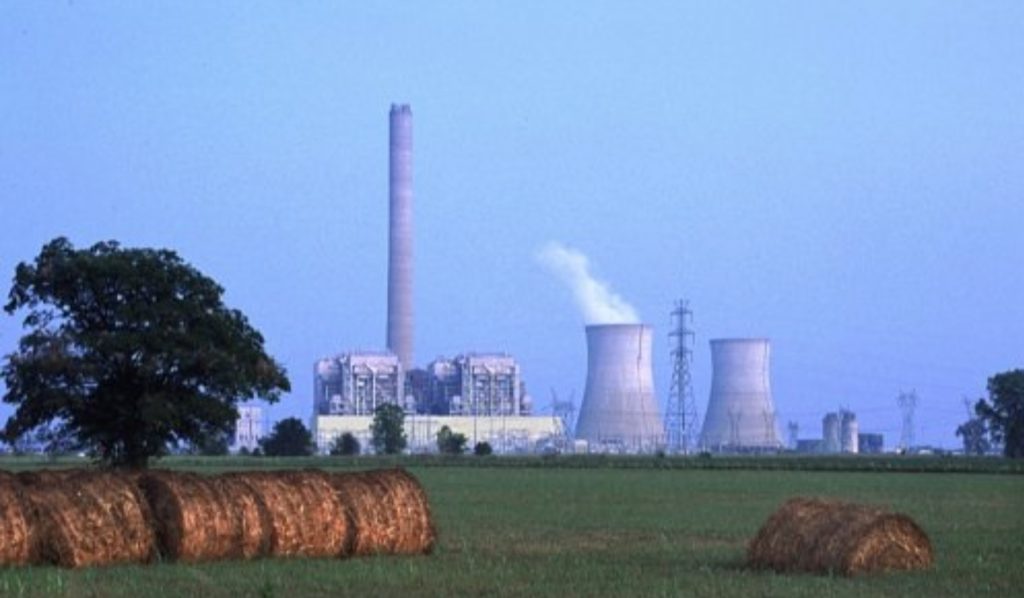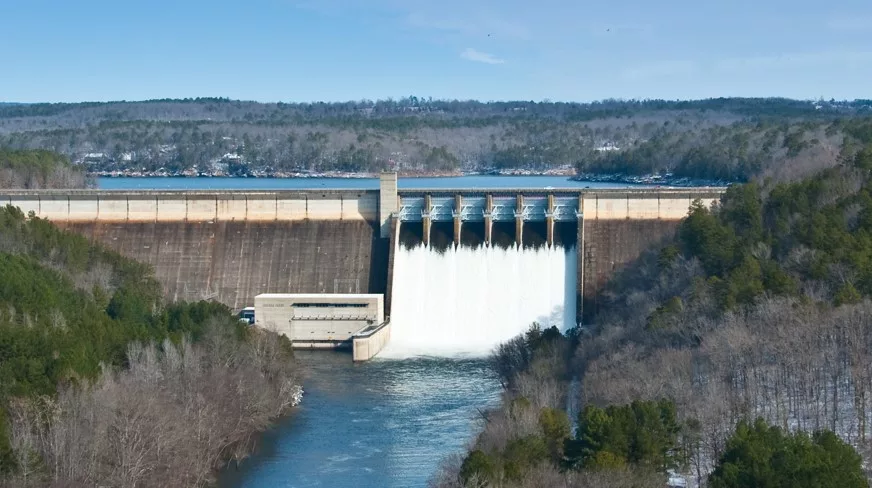
Above: Brad Lila (left), vice president of development of Cordelio Power, speaks before the Arkansas Senate Children and Youth Committee on Monday. In addition to the Crossover Wind Project near Wynne, Cordelio Power also has wind turbine projects in development in Independence, Jackson, and Woodruff counties.
Wind turbine developments in Independence and Jackson counties could be part of new energy efforts in the state
By Mary Hennigan, Arkansas Advocate
With some of Arkansas’ coal plants going offline by the end of the decade, renewable energy projects are needed to replace resources, industry professionals told state lawmakers Monday.
The state currently has zero operational wind projects, though three are in the works. While the state, along with others in the South, have been slow to initiate renewable energy projects, a map presented Monday showed much of Arkansas receives strong enough winds to support successful projects.
A new Environmental Protection Agency rule that’s being challenged in court would require many coal-fired plants to capture 90% of their carbon emissions or shut down within eight years, according to the Associated Press.
Prior to the release of the EPA rule in April, Entergy Arkansas already planned to close the state’s two largest coal-fired plants (the Independence County Power Plant coal-fired plant is due to be shut down in 2030) and a 50-year-old plant by the end of 2030 due to a 2021 settlement agreement, according to the Arkansas Democrat-Gazette.
 Entergy Arkansas’ Independence County Power Plant, which the utility is scheduled to close in 2030.
Entergy Arkansas’ Independence County Power Plant, which the utility is scheduled to close in 2030.
During a presentation to the Senate Children and Youth Committee on Monday, Brad Lila, vice president of development at Cordelio Power, told lawmakers that the more efficient wind turbines produced today are ideal for Arkansas’ landscape.
“The turbines are going taller, the blades are longer, but you capture more wind,” Lila said. “It’s kind of the secret sauce to building in the Delta area.”
Lila also told the committee Cordelio is developing wind turbine projects in Independence, Jackson, and Woodruff counties. The Cordelio executive said the Independence County site was chosen near the Independence County Power Plant location because once coal plants go off-line, there will be available line capacity in the area.
One modern turbine can generate up to three times the amount of energy a turbine produced five years ago, Lila said.
Cordelio Power is the owner of the Crossover Wind Project, a renewable energy project in Cross County. The 135 megawatt project is currently under construction and it is expected to become the state’s first operational wind farm next summer.
(Editor’s note — Lila also told the committee Cordelio is developing wind turbine projects in Independence, Jackson, and Woodruff counties. The Cordelio executive said the Independence County site was chosen near the Independence County Power Plant location because once coal plants go off-line, there will be available line capacity in the area.)
Sen. Ron Caldwell, a Republican who represents Cross County residents and joined Monday’s committee meeting as a guest, praised the work of Cordelio Power. He said he was thankful for the economic growth the project has offered.
Caldwell said most of the landowners who wanted a turbine on their property received one, and the windmills have an overall small imprint on the environment.
“I’m not trying to talk anyone into bringing them into their counties; if you don’t want them, vote against it,” Caldwell said. “But as far as we’re concerned in Cross County, and what I’ve been picking up in Woodruff and Jackson [counties] is that we’re all looking forward to having those facilities there and the revenue that comes from it.”
Sen. Bryan King, R-Green Forest, chaired the committee meeting and shared several concerns about a planned wind power project in Carroll County, which he represents.
King questioned how the 180 megawatt Nimbus project could affect the area’s eagle population, if snow would be flung thousands of feet when the blades spun after inclement weather, what the fire risks were and potential impacts to the region’s tourism.
Lila recognized all of King’s concerns and assured him that the wind turbines are built with enough space between them that they aren’t creating a dangerous space for the eagles. He also said that in Arkansas, the wind turbines will likely be more active at night when bird activity is lower.
The new windmills are built with flexible blades, which causes snow or ice to fall off easily at the base of the turbine when not in motion, Lila said. Fires in turbines are rare because the materials are not flammable, though if a fire did occur it would be contained, he added.
Referencing work he’s done in Michigan, Lila also said that wind turbines have become a reason for tourism themselves. He said he wasn’t aware of any areas in the country where turbines are prohibited because they would impact a scenic view.
Lila also told lawmakers that Cordelio Power installs a radar system in the turbines that triggers a blinking light only when a plane comes inside its set radius. The windmills also don’t exceed 50 decibels, which Lila compared to the sound of a refrigerator.
Simon Mahan of the Southern Renewable Energy Association said professionals typically study an area for years before they suggest a wind power project should be constructed in a community. Studies include bird and bat monitoring, wind strength and community input, he said.
Wind turbines generally have a 30-year lifespan, Mahan said.
“When the wind does blow, it’s a very good, low-cost energy resource,” Mahan said. “It is reliable. We can forecast days ahead of when the wind is going to go up and go down, and that gives the grid operators enough warning that they need to ramp up the coal or the natural gas.”
Mahan said the key to a stable grid is having backup resources that are used when the wind dies down.
Sen. Mark Johnson, R-Little Rock, asked when alternative resource projects, like natural gas, would be operational. Mahan didn’t give a specific timeline, but noted that solar and wind projects can be operational more quickly.
“We are starting to see a few more natural gas generators show up here in Arkansas and down in Louisiana,” Mahan said. “But [the] process can easily take two or three years.”
When asked by lawmakers, Mahan and Lila both referred to the renewable energy industry under President-elect Donald Trump’s first term positively and said they were not concerned about interference during his second term.
The Arkansas Advocate is a nonprofit, nonpartisan news organization dedicated to tough, fair daily reporting and investigative journalism that holds public officials accountable and focuses on the relationship between the lives of Arkansans and public policy.
Have a news tip or event to promote? Email White River Now at news@whiterivernow.com. Be sure to like and follow us on Facebook and Twitter. And don’t forget to download the White River Now mobile app from the Google Play Store or the Apple App Store.
Get up-to-date local and regional news/weather from the First Community Bank Newsroom on Arkansas 103.3 KWOZ every weekday morning and afternoon. White River Now updates are also aired weekday mornings on 93 KZLE, Outlaw 106.5, and Your FM 99.5.











